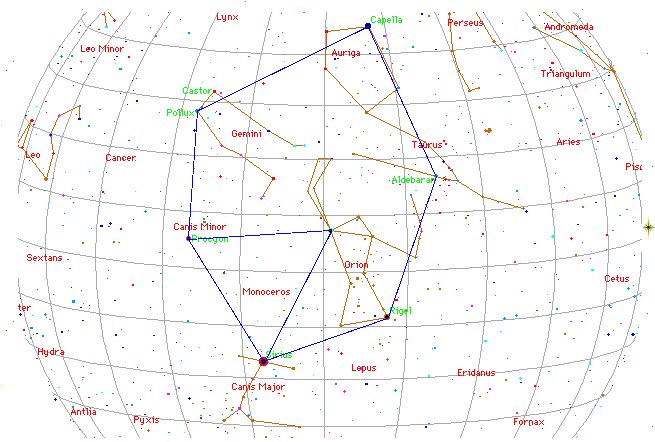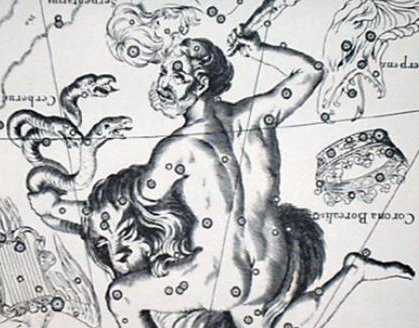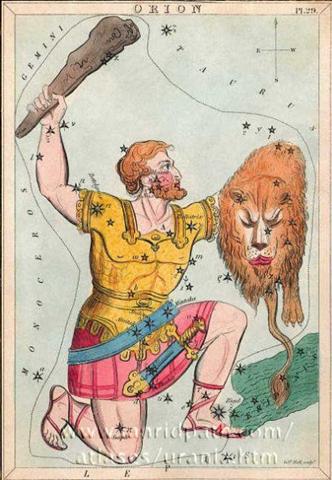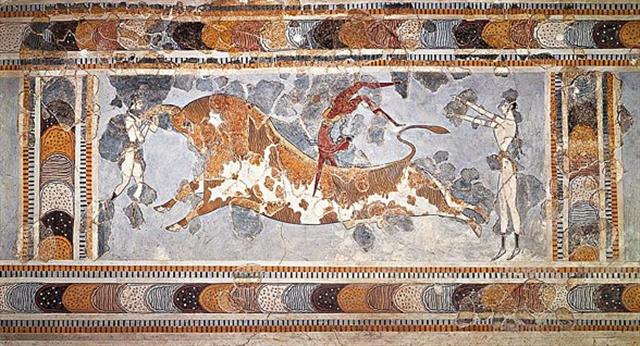402. A need-fire near a solstice should be located not by following the map of some ancient star positions but instead to be in tune with what could be observed at present.
... In ancient times the priest-astronomers (Brahmans) determined the recurrence of the solstices and equinoxes by the use of the gnomon ... Therefore, at this time of the year it seems, the Chinese had to abandon their calendar days 'about the beginning of April'. And presumably the G text at its hakaariki glyph should be connected with the current month of June (when the Club, Cujam, ε Herculi, *256) was visible close to the Full Moon:
The last glyph in line Gb5 should therefore refer to June 10. Similarly can we deduce that hakaariki in Ca4-7 should be connected with a current date. Its glyph number 83 hints at Heka (*83.2) - and if so with Rigel (*78.1) at Ca4-2:
I have suggested the beginning of side a on the C tablet probably was constructed to be at 0h (heliacal Sirrah), from which follows that Ca4-7 ought to be at Heka:
The arm hanging down in front in Ca4-7 probably indicated the opposite to the uplifted hand in Gb5-24 and in June 5 the month of Jus Piter (Father Light) had not yet arrived: ... The old man realized that he was now at a critical point. If the Nazarene did not understand this business of coming and going, he would not understand anything else. He wanted to say that what made life was not so much force as the movement of forces. He reverted to the idea of a universal shuttle service. 'The rays drink up the little waters of the earth, the shallow pools, making them rise, and then descend again in rain.' Then, leaving aside the question of water, he summed up his argument: 'To draw up and then return what one had drawn - that is the life of the world' ...
But a week later the Club of Orion would be hanging down (as viewed from Easter Island) in the Milky Way river:
... Ecclesiastically, the equinox is reckoned to be on 21 March (even though the equinox occurs, astronomically speaking, on 20 March in most years) ...
In order to make Heka coincide with hakaariki in Ca4-7 it might have been necessary to leap over 3 days in the Sun calendar, or alternatively to make the nights in the star calendar stand still - like when Vipunen sang and the sun, the moon, the waves in the sea, and even the waterfalles stood still to listern: ... Väinämöinen set about building a boat [→ Argo Navis], but when it came to the prow and the stern, he found he needed three words [183 - 180 = 3] in his rune that he did not know, however he sought for them. In vain he looked on the heads of the swallows, on the necks of the swans, on the backs of the geese, under the tongues of the reindeer. He found a number of words, but not those he needed. Then he thought of seeking them in the realm of Death, Tuonela, but in vain. He escaped back to the world of the living only thanks to his potent magic. He was still missing his three runes. He was then told by a shepherd to search in the mouth of Antero Vipunen, the giant ogre. The road, he was told, went over swords and sharpened axes. Ilmarinen made shoes, shirt and gloves of iron for him, but warned him that he would find the great Vipunen dead. Nevertheless, the hero went. The giant lay underground, and trees grew over his head. Väinämöinen found his way to the giant's mouth, and planted his iron staff in it. The giant awoke and suddenly opened his huge mouth. Väinämöinen slipped into it and was swallowed. As soon as he reached the enormous stomach, he thought of getting out. He built himself a raft and floated on it up and down inside the giant. The giant felt tickled and told him in many and no uncertain words where he might go, but he did not yield any runes. Then Väinämöinen built a smithy and began to hammer his iron on an anvil, torturing the entrails of Vipunen, who howled out magic songs to curse him away. But Väinämöinen said, thank you, he was very comfortable and would not go unless he got the secret words. Then Vipunen at last unlocked the treasure of his powerful runes. Many days and nights he sang, and the sun and the moon and the waves of the sea and the waterfalls stood still to hear him. Väinämöinen treasured them all and finally agreed to come out. Vipunen opened his great jaws, and the hero issued forth to go and build his boat at last ...
... A une certaine saison, on amassait des vivres, on faissait fête. On emmaillottait un corail, pierre de defunt lézard, on l'enterrait, tanu. Cette cérémonie était un point de départ pour beaucoup d'affaires, notamment de vacances pour le chant des tablettes ou de la prière, tanu i te tau moko o tana pure, enterrer la pierre sépulcrale du lézard de sa prière ...
|
|||||||||||||||||||||||||||||||||||||||||||||||||||||||||||||||||||||||||||||||||||||||||||||||||||||||||||||||||||||||||||||||||||||||||||||||||||||||||||||||||||||||||||||||||||||||||||||||||||























